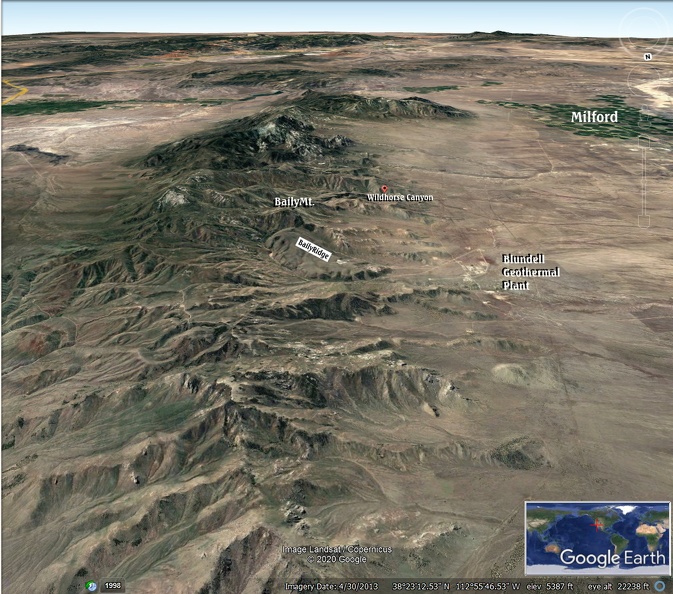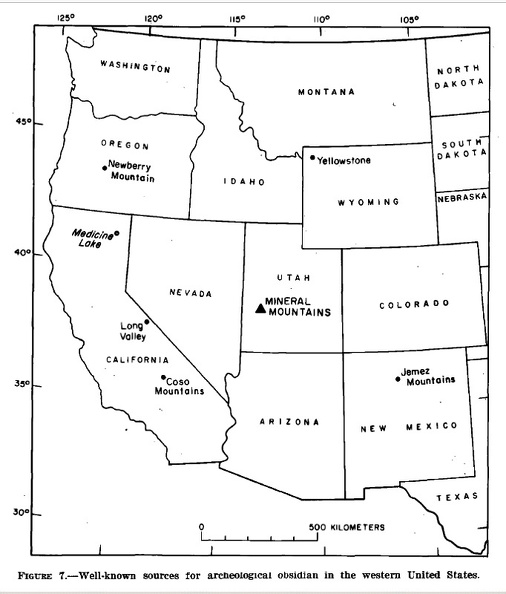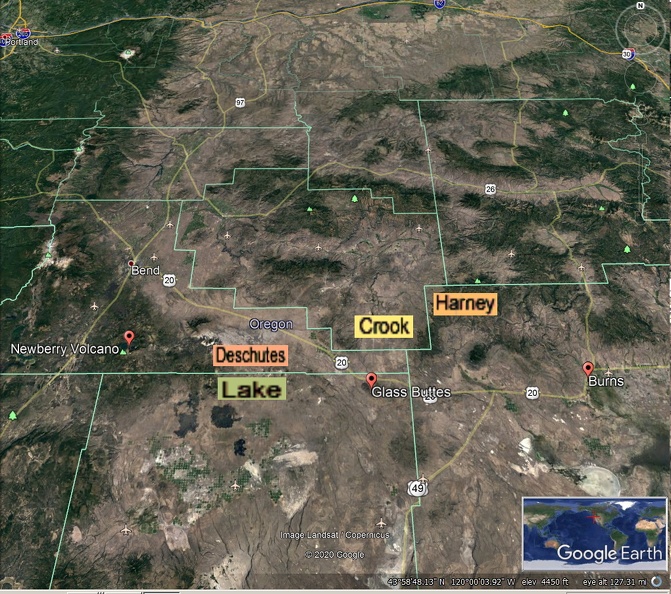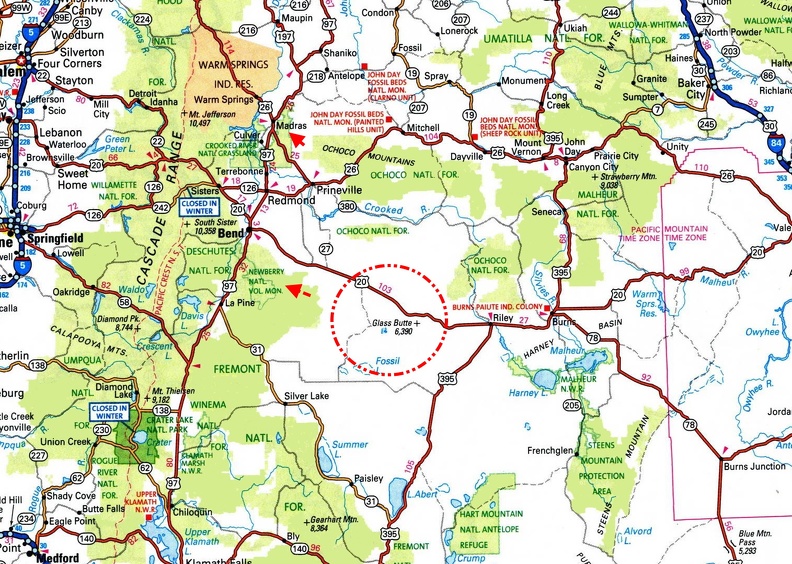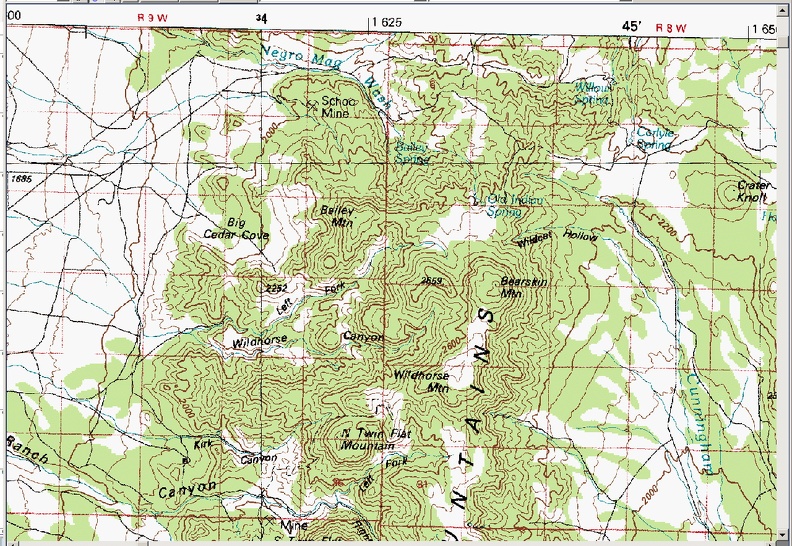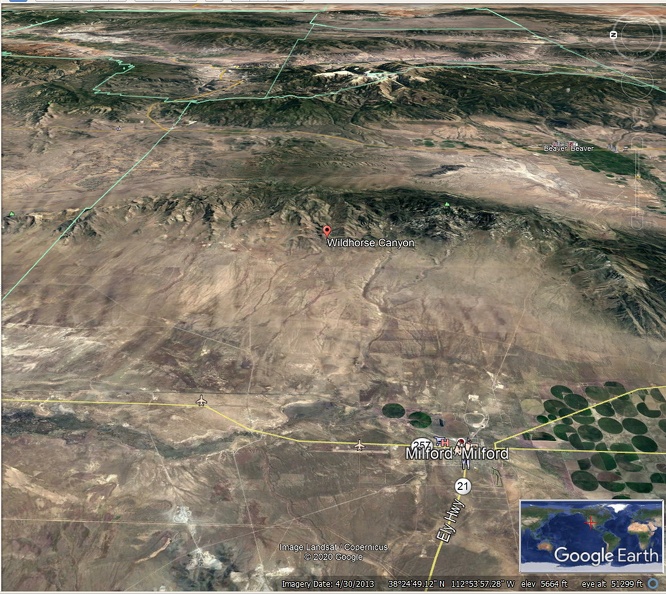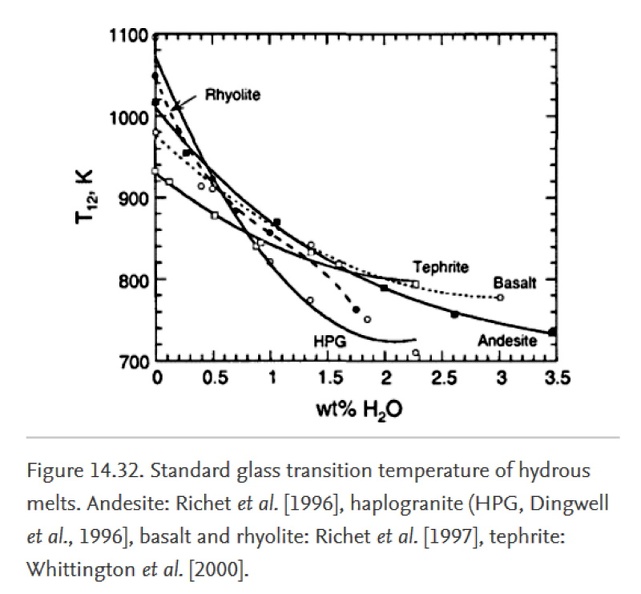Post by 1dave on Feb 27, 2020 17:36:54 GMT -5
volcano.oregonstate.edu/book/export/html/205
OBSIDIAN IS HOT STUFF
By Jim Miller, B.Sc., M.Sc. Geology*

Obsidian...even the name is exotic. Ever since I had my first rock collection as a child, I've loved obsidian. Sharp and shiny, obsidian is so different from other rocks. But until a few years ago when I made my first obsidian collecting trip to Glass Buttes, Oregon, I thought obsidian was pretty much just black glass. That amazing trip really opened my eyes. The ancient volcanic hills called Glass Buttes hold a dazzling variety of gem-quality obsidian, including: mahogany, red, flame, midnight lace, jet black, pumpkin, brown, rainbow, gold sheen, silver sheen, green, lizard skin, snowflake and more. My goal in this article is to increase your awareness of some of the more fascinating aspects of this incredible stone.
Obsidian is natural glass that was originally molten magma associated with a volcano. This volcanic glass has an almost total absence of sizable mineral crystals within the glass matrix. When I say "crystals," don't visualize those beautiful pointed prisms of quartz found in geodes. All rocks consist of mixtures of various crystalline minerals. When crystallization occurs, the atoms that comprise a mineral become arranged in regular, geometric patterns that are unique to the specific mineral. Crystal faces form only where there is enough open space in the rock mass to allow the natural geometric forms of the crystals to develop as free faces. Granite is composed entirely of intergrown crystals of quartz, feldspar, mica and other minerals. These relatively large mineral crystals (easily visible to the naked eye) give granite a rough fracture surface.
Like all glass and some other types of naturally occurring rocks, obsidian breaks with a characteristic "conchoidal" fracture. This smooth, curved type of fracture surface occurs because of the near-absence of mineral crystals in the glass. The intersections of conchoidal fracture surfaces can be sharper than a razor. This had obvious advantages for our Stone Age ancestors, who used obsidian extensively for tool making.
Obsidian consists of about 70 percent or more non-crystallized silica (silicon dioxide). It is chemically similar to granite and rhyolite, which also were originally molten. Because obsidian is not comprised of mineral crystals, technically obsidian is not a true "rock." It is really a congealed liquid with minor amounts of microscopic mineral crystals and rock impurities. Obsidian is relatively soft with a typical hardness of 5 to 5.5 on the mineral hardness scale. In comparison, quartz (crystallized silicon dioxide) has a hardness of 7.0.
Obsidian occurs only where geologic processes create volcanoes and where the chemical composition of the magma is rich in silica. Obsidian-bearing volcanoes are typically located in or near areas of crustal instability or mountain building. In North America, obsidian is found only in localized areas of the West, where the processes of plate tectonics have created geologic conditions favorable to volcanism and the formation of obsidian. Obsidian typically forms near the end of a volcanic cycle and is often associated with domes of volcanic rock, such as the hills of Glass Buttes, Oregon.
If obsidian is similar in composition to granite and rhyolite, both of which were originally molten, then why is obsidian glassy? The answer relates to the original cooling rate and water content of the magma. Granite cools very slowly miles below the surface of the earth; this slow cooling over millions of years allows for the formation of sizable mineral crystals within the slowly cooling mass of molten rock. Rhyolite typically cools more rapidly near the earth's surface and contains smaller mineral crystals than granite. When rhyolite magma approaches the earth's surface and the pressure of burial decreases, most of the water in the magma is lost as steam. The resulting silica-rich magma with little remaining water becomes very viscous (thick and pasty) obsidian magma. This magma is so viscous that sizable mineral crystals cannot grow before chilling of the magma "freezes" crystal development.
Some obsidian is erupted as lava flows at the ground surface. These surface flows are so viscous that they flow very slowly. One article I read indicated that "an ant could probably outrun an obsidian lava flow." An excellent example of a relatively recent obsidian flow can be found at Paulina Lake (part of the Newberry Volcano), approximately 30 miles southeast of Bend, Oregon. Portions of this obsidian flow are mixed with layers of pumice, a glassy, bubble-rich, lightweight rock that develops when water vapor (steam) escapes rapidly from the molten glass at or near the ground surface.
Sometimes obsidian of excellent quality develops as surface lava flows. However, the best quality obsidian often forms below the ground surface around volcanic vents. Silica-rich magma squeezes into rock fractures to form layers and lenses of obsidian that are relatively free of dirt, ash and other impurities.
Changes in magma composition and water content often occur during the eruption and subsurface emplacement of obsidian flows. The high viscosity of the molten obsidian prevents effective mixing of these magmas, resulting in obsidian that is "streaked" with different layers or colors. Each of these streaks or lines may represent a distinct pulse of an obsidian eruption. You can visualize the process that results in streaked obsidian if you consider two blobs of green and red taffy (a viscous candy) that are mixed together. Distinct streaks of red and green taffy result as the blobs are mixed. In the case of obsidian, the slow flow of stiff, viscous magma away from the source vent provides the mixing needed to create the layered or streaked varieties of obsidian. The "midnight lace" variety of obsidian often has incredibly contorted streaking, apparently formed as the obsidian layers were stretched and rolled with slow movement of the magma.
The various colors of obsidian are a result of several factors. Clear varieties of obsidian contain very few opaque impurities or microscopic mineral crystals. Red or brown obsidian generally results from tiny crystals or inclusions of hematite or limonite (iron oxide). Abundant, microscopic crystals of minerals like magnetite, hornblende, pyroxene, plagioclase and biotite, combined with tiny fragments of rock, likely produce the jet-black varieties of obsidian. Microscopic crystals of various types of feldspars may yield the unique blue, green, purple or bronze colors associated with rainbow obsidian. The reflectance of rainbow obsidian is likely attributed to a preferred orientation of microscopic crystals of feldspar or mica oriented along flow layers.
A certain amount of water always is present in obsidian. Very small inclusions of water vapor in the form of bubbles often are trapped in the glass. Tiny gas bubbles that have been stretched nearly flat along the flow layers in obsidian generally cause the reflectance of gold sheen and silver sheen obsidian. Some of these bubbles are visible to the naked eye. The bubbles can be seen readily with a strong magnifying glass or a microscope.
Obsidian is relatively unstable from a geologic perspective. It is rare to find obsidian older than about 20 million years, which is very youthful in comparison to most continental rocks that form the Earth's crust. Over a long period of time, obsidian gradually changes from glass to rock in a process known as "devitrification." In this process, the silica molecules within the glass slowly rearrange into organized crystal patterns. The "snowflakes" in snowflake obsidian are quartz crystals that have formed through devitrification of the original obsidian. The crystals that develop through devitrification cause obsidian to lose its conchoidal fracture and glassy texture.
Native Americans discovered almost all of the obsidian locations in North America. Each obsidian source area has a unique assemblage of trace elements, allowing identification of the original source locality for the obsidian used in prehistoric artifacts. Trace element analyses have shown that native peoples traded this valuable commodity many hundreds of miles from the volcanic source areas along numerous trade routes. The fact that obsidian was transported great distances attests to the mystique of this unique material.
My favorite place to collect obsidian is Glass Buttes in central Oregon. A trip to Glass Buttes is well worth the effort for the natural scenery, abundant and beautiful gem-quality obsidian, and exploration of a fascinating geological area. These sagebrush- and juniper-covered hills are remote but accessible by automobile. Located in central Oregon south of Highway 20 and about 80 miles east of Bend, a visitor will be rewarded with many different varieties of obsidian through exploration of the area. Fist-sized pieces are abundant and can be collected with no digging. For large pieces of high quality obsidian (ranging up to several hundred pounds), considerable effort with a shovel and pry bar are necessary. Further information on Glass Buttes can be found in several rockhound guidebooks that include the central Oregon area.
* Jim Miller is a practicing geologist and an avid flint knapper residing in Bothell, Washington. Examples of obsidian from Glass Buttes and stone tools made from those materials by the author are included with this article.

Several varieties of obsidian from Glass Buttes, Oregon and tools made by the author from those materials. From left to right across the top, the obsidian varieties are silver sheen, midnight lace, pumpkin and red mahogany.

Source material and stone tools of red mahogany obsidian.
Source material and stone tools of red mahogany obsidian. Pencil gives scale.

Source material and stone tool of silver sheen obsidian.
Source material and stone tools of pumpkin obsidian. Pencil gives scale.
Multi-colored streaks oriented along flow lines in midnight lace obsidian.
Contorted streaks within midnight lace obsidian.
OBSIDIAN IS HOT STUFF
By Jim Miller, B.Sc., M.Sc. Geology*

Obsidian...even the name is exotic. Ever since I had my first rock collection as a child, I've loved obsidian. Sharp and shiny, obsidian is so different from other rocks. But until a few years ago when I made my first obsidian collecting trip to Glass Buttes, Oregon, I thought obsidian was pretty much just black glass. That amazing trip really opened my eyes. The ancient volcanic hills called Glass Buttes hold a dazzling variety of gem-quality obsidian, including: mahogany, red, flame, midnight lace, jet black, pumpkin, brown, rainbow, gold sheen, silver sheen, green, lizard skin, snowflake and more. My goal in this article is to increase your awareness of some of the more fascinating aspects of this incredible stone.
Obsidian is natural glass that was originally molten magma associated with a volcano. This volcanic glass has an almost total absence of sizable mineral crystals within the glass matrix. When I say "crystals," don't visualize those beautiful pointed prisms of quartz found in geodes. All rocks consist of mixtures of various crystalline minerals. When crystallization occurs, the atoms that comprise a mineral become arranged in regular, geometric patterns that are unique to the specific mineral. Crystal faces form only where there is enough open space in the rock mass to allow the natural geometric forms of the crystals to develop as free faces. Granite is composed entirely of intergrown crystals of quartz, feldspar, mica and other minerals. These relatively large mineral crystals (easily visible to the naked eye) give granite a rough fracture surface.
Like all glass and some other types of naturally occurring rocks, obsidian breaks with a characteristic "conchoidal" fracture. This smooth, curved type of fracture surface occurs because of the near-absence of mineral crystals in the glass. The intersections of conchoidal fracture surfaces can be sharper than a razor. This had obvious advantages for our Stone Age ancestors, who used obsidian extensively for tool making.
Obsidian consists of about 70 percent or more non-crystallized silica (silicon dioxide). It is chemically similar to granite and rhyolite, which also were originally molten. Because obsidian is not comprised of mineral crystals, technically obsidian is not a true "rock." It is really a congealed liquid with minor amounts of microscopic mineral crystals and rock impurities. Obsidian is relatively soft with a typical hardness of 5 to 5.5 on the mineral hardness scale. In comparison, quartz (crystallized silicon dioxide) has a hardness of 7.0.
Obsidian occurs only where geologic processes create volcanoes and where the chemical composition of the magma is rich in silica. Obsidian-bearing volcanoes are typically located in or near areas of crustal instability or mountain building. In North America, obsidian is found only in localized areas of the West, where the processes of plate tectonics have created geologic conditions favorable to volcanism and the formation of obsidian. Obsidian typically forms near the end of a volcanic cycle and is often associated with domes of volcanic rock, such as the hills of Glass Buttes, Oregon.
If obsidian is similar in composition to granite and rhyolite, both of which were originally molten, then why is obsidian glassy? The answer relates to the original cooling rate and water content of the magma. Granite cools very slowly miles below the surface of the earth; this slow cooling over millions of years allows for the formation of sizable mineral crystals within the slowly cooling mass of molten rock. Rhyolite typically cools more rapidly near the earth's surface and contains smaller mineral crystals than granite. When rhyolite magma approaches the earth's surface and the pressure of burial decreases, most of the water in the magma is lost as steam. The resulting silica-rich magma with little remaining water becomes very viscous (thick and pasty) obsidian magma. This magma is so viscous that sizable mineral crystals cannot grow before chilling of the magma "freezes" crystal development.
Some obsidian is erupted as lava flows at the ground surface. These surface flows are so viscous that they flow very slowly. One article I read indicated that "an ant could probably outrun an obsidian lava flow." An excellent example of a relatively recent obsidian flow can be found at Paulina Lake (part of the Newberry Volcano), approximately 30 miles southeast of Bend, Oregon. Portions of this obsidian flow are mixed with layers of pumice, a glassy, bubble-rich, lightweight rock that develops when water vapor (steam) escapes rapidly from the molten glass at or near the ground surface.
Sometimes obsidian of excellent quality develops as surface lava flows. However, the best quality obsidian often forms below the ground surface around volcanic vents. Silica-rich magma squeezes into rock fractures to form layers and lenses of obsidian that are relatively free of dirt, ash and other impurities.
Changes in magma composition and water content often occur during the eruption and subsurface emplacement of obsidian flows. The high viscosity of the molten obsidian prevents effective mixing of these magmas, resulting in obsidian that is "streaked" with different layers or colors. Each of these streaks or lines may represent a distinct pulse of an obsidian eruption. You can visualize the process that results in streaked obsidian if you consider two blobs of green and red taffy (a viscous candy) that are mixed together. Distinct streaks of red and green taffy result as the blobs are mixed. In the case of obsidian, the slow flow of stiff, viscous magma away from the source vent provides the mixing needed to create the layered or streaked varieties of obsidian. The "midnight lace" variety of obsidian often has incredibly contorted streaking, apparently formed as the obsidian layers were stretched and rolled with slow movement of the magma.
The various colors of obsidian are a result of several factors. Clear varieties of obsidian contain very few opaque impurities or microscopic mineral crystals. Red or brown obsidian generally results from tiny crystals or inclusions of hematite or limonite (iron oxide). Abundant, microscopic crystals of minerals like magnetite, hornblende, pyroxene, plagioclase and biotite, combined with tiny fragments of rock, likely produce the jet-black varieties of obsidian. Microscopic crystals of various types of feldspars may yield the unique blue, green, purple or bronze colors associated with rainbow obsidian. The reflectance of rainbow obsidian is likely attributed to a preferred orientation of microscopic crystals of feldspar or mica oriented along flow layers.
A certain amount of water always is present in obsidian. Very small inclusions of water vapor in the form of bubbles often are trapped in the glass. Tiny gas bubbles that have been stretched nearly flat along the flow layers in obsidian generally cause the reflectance of gold sheen and silver sheen obsidian. Some of these bubbles are visible to the naked eye. The bubbles can be seen readily with a strong magnifying glass or a microscope.
Obsidian is relatively unstable from a geologic perspective. It is rare to find obsidian older than about 20 million years, which is very youthful in comparison to most continental rocks that form the Earth's crust. Over a long period of time, obsidian gradually changes from glass to rock in a process known as "devitrification." In this process, the silica molecules within the glass slowly rearrange into organized crystal patterns. The "snowflakes" in snowflake obsidian are quartz crystals that have formed through devitrification of the original obsidian. The crystals that develop through devitrification cause obsidian to lose its conchoidal fracture and glassy texture.
Native Americans discovered almost all of the obsidian locations in North America. Each obsidian source area has a unique assemblage of trace elements, allowing identification of the original source locality for the obsidian used in prehistoric artifacts. Trace element analyses have shown that native peoples traded this valuable commodity many hundreds of miles from the volcanic source areas along numerous trade routes. The fact that obsidian was transported great distances attests to the mystique of this unique material.
My favorite place to collect obsidian is Glass Buttes in central Oregon. A trip to Glass Buttes is well worth the effort for the natural scenery, abundant and beautiful gem-quality obsidian, and exploration of a fascinating geological area. These sagebrush- and juniper-covered hills are remote but accessible by automobile. Located in central Oregon south of Highway 20 and about 80 miles east of Bend, a visitor will be rewarded with many different varieties of obsidian through exploration of the area. Fist-sized pieces are abundant and can be collected with no digging. For large pieces of high quality obsidian (ranging up to several hundred pounds), considerable effort with a shovel and pry bar are necessary. Further information on Glass Buttes can be found in several rockhound guidebooks that include the central Oregon area.
* Jim Miller is a practicing geologist and an avid flint knapper residing in Bothell, Washington. Examples of obsidian from Glass Buttes and stone tools made from those materials by the author are included with this article.

Several varieties of obsidian from Glass Buttes, Oregon and tools made by the author from those materials. From left to right across the top, the obsidian varieties are silver sheen, midnight lace, pumpkin and red mahogany.

Source material and stone tools of red mahogany obsidian.
Source material and stone tools of red mahogany obsidian. Pencil gives scale.

Source material and stone tool of silver sheen obsidian.
Source material and stone tools of pumpkin obsidian. Pencil gives scale.
Multi-colored streaks oriented along flow lines in midnight lace obsidian.
Contorted streaks within midnight lace obsidian.

